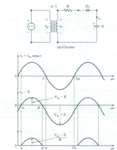julian403
Full Member level 5
Hello, I was doing this exercise from power electronic circuits by Rashid.

It's a battery charge's circuit. You can see there that there is a half rectifier bridge and There is a driving angle call alpha because the battery potential difference.
If the secundary transformer voltage is - 60 sen (2 Π 60 t) [V] - and the battery's voltage is 12[V]. The way to find alpha for me is:
\[\alpha = {sin}^{-1} (\frac{12[V]}{60[V]}) = 0.201 rad\]
But the Rashid instead use the peak value which in this case is 60[V] use the average value. Why?


It's a battery charge's circuit. You can see there that there is a half rectifier bridge and There is a driving angle call alpha because the battery potential difference.
If the secundary transformer voltage is - 60 sen (2 Π 60 t) [V] - and the battery's voltage is 12[V]. The way to find alpha for me is:
\[\alpha = {sin}^{-1} (\frac{12[V]}{60[V]}) = 0.201 rad\]
But the Rashid instead use the peak value which in this case is 60[V] use the average value. Why?
